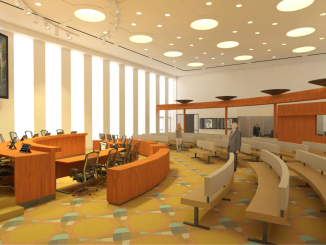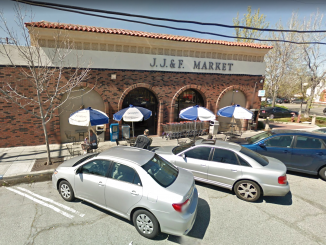
OPINION
BY DAVE PRICE
Daily Post Editor
If you think driving is more difficult in Palo Alto these days, it’s not your imagination. In fact, it’s intentional.
The city of Palo Alto is spending $8.7 million to install 11 roundabouts and make other changes to residential streets in an attempt to make things safer for bicyclists and pedestrians.
But this project’s first roundabout at Ross Road and E. Meadow Drive has turned out to be a disaster.
Here’s the problem: There are stop signs on all four sides of the intersection. You stop and then enter the circle, and spin to the street where you want to go.
In other places, the advantage of a roundabout is that you don’t have to stop. You drive into the circle and exit where you want. No stop sign or stop light is needed. In fact, roundabouts have been used in some cities to replace stop lights.
The stop signs defeat the purpose of a circle. If you’re going to stop and drive forward, why do you need the barrier in front of you?
(Update: After this column was printed, City Spokeswoman Claudia Keith told the Post that the stop signs at the roundabout are temporary. They’ll be converted to yield signs when the work is finished.)
Residents livid
And understandably, drivers are confused. For instance, what do you do when you enter the circle and there’s a pedestrian crossing the street you want to enter? You hit the brakes and clog up the circle for other cars.
People who live nearby are livid. They’ve started an online petition at change.org. As of yesterday, 650 people had signed it.
“This is not one resident complaining that they lost a parking space,” the petition states. “This is dozens of neighbors trying to raise the alarm before an elementary school bike commuter is crushed by a minivan; before an ambulance is stranded on a concrete island; before another confrontation between two cars given no buffer passing each other in arbitrary constrictions.”
The roundabout at Meadow and Ross is a taste of what’s to come. Ten more roundabouts are planned:
• Bryant Street at Poe Street and Palo Alto Avenue;
• Bryant and N. California Avenue;
• Bryant and Loma Verde Avenue;
• Bryant and Kingsley Avenue;
• Ross Road and Moreno Avenue;
• Ross and Louis Road;
• Louis Road and E. Meadow;
• E. Meadow Drive and E. Meadow Circle;
• Amarillo Avenue and Greer Road;
• Bryant and Addison Avenue (conversion from a “traffic circle” to a full-blown roundabout).
How it happened
These roundabouts are the result of a very effective effort by the bicycling community to lobby city hall. The drivers who use these roads only started paying attention when the construction started.
And council approved a Bicycle & Pedestrian Transportation Plan back in 2012 that called for all these changes without thinking through the consequences.
Curb extensions
Another mystery about these changes are the curb extensions. We’re told that they are intended to reduce speed by making drivers perceive the road to be narrower. People slow down on narrow streets. But the problem with these extensions is that they push bicyclists into the path of cars.
The city insists that the curb extensions only extend into what would be the parking lane, and that there’s still enough room for cars and bikes to share the road.
Maybe. But to my untrained eyes, it looks like an accident waiting to happen.
The bicycle groups should be outraged at this.
Complaining, though, doesn’t do a lot of good. Council received the online petition but approved only minor changes last Monday. Council members did nothing to stop the roundabouts. Hopefully it won’t take a child’s death to focus council’s attention on the problems this project is creating. At the very least, it sounds like an issue for this fall’s council race.
Editor Dave Price’s column appears on Mondays. His email address is [email protected].




Ten more of them! They can’t be serious.
The entrance to the roundabout is designed to slow traffic to about 15 mph. The safest way for bicyclists to go through a roundabout is to follow the same rules as a car and occupy the full lane. The manual on road markings and signage (Manual of Uniform Traffic Control Devices) says you should NOT have a bike lane in a roundabout — either the bicyclist merges in with the vehicles or they get off the road and become pedestrians… which means *walking* their bike. Roundabouts like this are very common in other countries and work quite well, and the lessons learned there have been incorporated into the design guidelines that the Federal Highway Works Administration publishes and the states generally use as the basis for their designs.
I don’t know what Dave Price’s problem is, except maybe he doesn’t like things to change. But roundabouts work great. They’re all over Europe. Europeans seem to be more sophisticated in many ways, and a roundabout doesn’t phase them. When all 11 of these are installed, I think everybody will be happy and want more of them.
European roundabouts are many times bigger than these eyesores, allowing for smooth entry and exit. These are intersections with concrete islands in the middle and pose a major hazard, especially for children on bicycles (or adult bicyclists with the mentality of children). Drinking grape juice and calling it fine wine doesn’t make you “sophisticated”, it makes you a fool.
Neighborhood traffic circles are not modern roundabouts, but they are not unsafe.
Many people confuse other and older styles of circular intersections with modern roundabouts. High speed, east coast rotaries, large multi-lane traffic circles (Arc D’Triomphe, Dupont Circle), and small neighborhood traffic circles are not modern roundabouts.
The Brits even call a merry-go-round a kid’s roundabout.
Go to http://www.k-state.edu/roundabouts/photos.htm to see pictures.
What is, and is not, a modern roundabout:
WA DOT: http://www.youtube.com/watch?v=vsCoI7lERGE
NJ traffic circles: https://en.wikipedia.org/wiki/List_of_traffic_circles_in_New_Jersey
NJ wins award for building roundabout:
https://www.prnewswire.com/news-releases/national-roadway-safety-award-winners-announced-300556007.html
Neighborhood traffic circles are not modern roundabouts, but they are not hazardous to law abiding citizens.
The Ross meadow roundabout is a failure. It needs to be removed now. Sign the petition and email your council members. Remove it now!!!
To clarify, some who live nearby are livid. I live nearby, and use the roundabout every day–as both cyclist and driver. I find it to be an improvement with regards to both safety and efficiency.
Shoddy journalism to not do any homework on your major objection (the stop signs). This piece is full of misleading statements.
Since you’re so informed about this, what problem was the city trying to solve at Ross Rd and Meadow? If you say “accidents” do you have any stats or other evidence to back that up?
The petition now stands at 732, not 650. https://www.change.org/p/city-council-cityofpaloalto-org-stop-the-traffic-calming-implementation-on-ross-road-in-palo-alto
There’s talk of a city-wide petition, not just for Ross Road. There’s also related problems of other types of road barriers, pinch points and restriping of roads to impede through traffic. What a waste of our time and money when the city’s pleading poverty.
If there is going to be a citywide petition, make sure everybody knows about it. I’ll sign it!
Bruce –
I think it is fair to say that the work is not finished, and that the city plans to remove the stop signs when the roundabout is completed. I think it is also fair to point out that 732 people have signed a petition asking the city to stop building additional roundabouts and to reconsider the design at East Meadow and Ross Road. Many of us have no objection to roundabouts, but a strong objection to this implementation. Before we continue to reproduce this design, we should understand why people object.
The center island is too large for a mini-roundabout with a diameter of 64-feet, and this implementation should be completely traversable. The curbs should all be rolled (not sharp), and the sidewalks should not be extended as bulbouts. The bike lane should end before the roundabout, but not abruptly (it currently ends in six feet, and should taper for 25-30).
Many of the people opposed to the design of this intersection are bike enthusiasts who embrace roundabouts. But it is important that the design fit the circumstances, and what has been built is not safe. More signs, more lights, and a cleaner apron are not going to fix this mini-roundabout. Small children and first-year bikers should not be forced into the lane of traffic, and bikes should not ride on sidewalks.
Reasonable people may reasonably disagree with each other. That’s why it is really important that published design guidelines (like NCHRP REPORT 672 Subscriber Categories Highways • Design Roundabouts: An Informational Guide Second Edition) be followed. They were not followed in this design.
George
It’s not a mini-roundabout, it’s a neighborhood traffic circle.
One of the differences between the UK and here, is that pedestrians never have the right of way unless there is zebra crossing. This means that at a roundabout the pedestrians have to stop and wait until it is clear to cross. At roundabouts, the traffic islands are designed as pedestrian waiting areas so that pedestrians cross each part of the road separately, crossing half way and then waiting again to cross the other side. This means that pedestrians crossing at a roundabout only have to be concerned about traffic coming in one direction and they have to wait until it is clear before they start to cross. The design of the Ross/Meadow roundabout is very different as the traffic island is not a pedestrian waiting area and since pedestrians have right of way here it will mean that traffic will have to stop on the roundabout waiting for the pedestrians to cross both directions of traffic.
I’ll bet dollars to donuts that the stop signs are never removed. Mountain View left them in after installing similar central intersection obstructions. These are not traffic circles -or- roundabouts, they are in place solely to impede or “calm” vehicular traffic at the behest of a small cadre of adult bicycle riders.
I’ll bet dollars to donuts that the stop signs are never removed. Mountain View left them in after installing similar central intersection obstructions. These are not traffic circles -or- roundabouts, they are in place solelxy to impede or “calm” vehicular traffic at the behest of a small cadre of adult bicycle riders.
These roundabouts, or whatever you call them, would work better if the lanes in the circle were wider. I can’t see how a car and bike can proceed safely together in this roundabout. Either one has to stop or the other. This is dangerous and unnecessary. Wonder how the City will spin it when the first bicyclist is killed?
Killed? at 15 mph? or because you can’t see them coming?
They don’t proceed together. they follow each other in and take turns, like any other vehicle would.